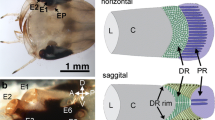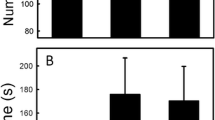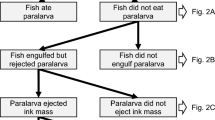Summary
1. The Italian bolitoglossine salamanderHydromantes italicus shows a periodic cave life. In spring and in the fall it leaves the caves after which it lives under stones, in leaves and crevices. Inside the limestone caves,H. i. can be found both in the zone of dim light near the entrance and in total darkness. 2. Corresponding to these two environments there are two guidance systems of the prey catching behavior: one visual and one olfactory. 3. The visually guided prey catching behavior is determined by the stimulus parameters: velocity, size, contrast, and ambient illumination. Continuously moving objects are effective within a velocity range of 0.05 to 6 cm/s with an optimum at 1.25 cm/s (Fig. 2). Stimuli moving stepwise elicit fixation of the prey and complete approach more frequently than continuously moving stimuli. The prey size which elicits prey catching ranges from 0.5 to 10 mm2 with an optimum size between 2.5–5.0 mm2 (Fig. 3). The prey catching behavior is hardly impaired by a decrease in ambient illumination down to 0.03 cd/m2. Beyond 0.03 cd/m2, the prey catching activity decreases sharply, but there are still responses at an illumination level of 0.003 cd/m2 (Fig. 4). 4.H.i. also responds to stationary non-smelling visual stimuli following stimulation by smell or movement.H.i. is able to detect prey by smell only both in total darkness and in the light (Fig. 5 A). In the light, the prey catching behavior with regard to smelling objects is inhibited by the absence of visual contrast (Fig. 5B).
Similar content being viewed by others

References
Autrum, H.: Das Fehlen unwillkürlicher Augenbewegungen beim Frosch. Naturwissenschaften46, 435 (1959)
Cronly-Dillon, J.R., Galand, G.: Analyse des réponses visuelles dans le nerf optique et le tectum du Triton,Triturus vulgaris. J. Physiol. (Paris)58, 502–503 (1966)
Ewert, J.-P.: Der Einfluß von Zwischenhirndefekten auf die Visuomotorik im Beute- und Fluchtverhalten der Erdkröte (Bufo bufo L.). Z. vergl. Physiol.61, 41–70 (1968)
Ewert, J.-P.: Lokalisation und Identifikation im visuellen System der Wirbeltiere. Fortschr. Zool.21, 307–333 (1973)
Ewert, J.-P.: The visual system of the toad: behavioral and physiological studies on a pattern recognition system. In: The amphibian visual system: a multidisciplinary approach (ed., K.V. Fite). New York: Acad. Press 1976, in press
Ewert, J.-P., Borchers, H.-W.: Antwort von retinalen Ganglienzellen bei freibeweglichen Kröten (Bufo bufo L.). J. comp. Physiol.92, 117–130 (1974)
Finkelstein, D., Grüsser, O.-J.: Frog retina: detection of movement. Science150, 1050–1051 (1965)
Grüsser, O.-J., Finkelstein, D., Grüsser-Cornehls, U.: The effect of stimulus velocity on the response of movement sensitive neurons of the frog's retina. Pflügers Arch. ges. Physiol.300, 49–66 (1968)
Grüsser-Cornehls, U., Himstedt, W.: Responses of retinal and tectal neurons of the salamander (Salamandra salamandra L.) to moving visual stimuli. Brain, Behav. Evol.7, 145–168 (1973)
Himstedt, W.: Experimentelle Analyse der optischen Sinnesleistungen im Beutefangverhalten der einheimischen Urodelen. Zool. Jb. (Physiol.)73, 281–320 (1967)
Hinsehe, G.: Ein Schnappreflex nach “Nichts” bei Anuren. Zool. Anz.111, 113–122 (1935)
Lettvin, J.Y., Maturana, H.R., McCulloch, W.S., Pitts, W.H.: What the frog's eye tells the frog's brain. Proc. Inst. Radio Engrs.47, 1940–1945 (1959)
Schipperheyn, J.J.: Contrast detection in frog retina. Acta physiol. pharmacol. néerl.13, 231–277 (1965)
Schneider, D.: Beitrag zu einer Analyse des Beute- und Fluchtverhaltens einheimischer Anuren. Biol. Zbl.73, 225–282 (1954)
Wake, D.B.: Comparative osteology and evolution of the lungless salamanders, family Plethodontidae. Memoirs So. Calif. Acad. Sci.4, 1–111 (1966)
Wake, D.B., Lombard, R.E.: Feeding mechanisms and the evolution of plethodontid salamanders. HISS News-J.1 (2), 164–165 (1973)
Wake, D.B., Lombard, R.E.: Tongue evolution in the lungless salamanders, family Plethodontidae. I. Introduction, theory, and a general model of dynamics. J. Morph., in press (1975)
Author information
Authors and Affiliations
Additional information
I would like to thank Prof. Dr. R. Altevogt, University of Münster (Germany) for his generous help and constant encouragement. Furthermore, I want to express my gratitude to Prof. Dr. D.B. Wake, University of California, Berkeley (USA), Prof. Dr. P. Mancino, University of Pisa (Italy), and Prof. Dr. J.-P. Ewert, University (GH) of Kassel (Germany) for stimulating discussions and helpful comments.
Rights and permissions
About this article
Cite this article
Roth, G. Experimental analysis of the prey catching behavior ofHydromantes italicus Dunn (Amphibia, Plethodontidae). J. Comp. Physiol. 109, 47–58 (1976). https://doi.org/10.1007/BF00663434
Received:
Issue Date:
DOI: https://doi.org/10.1007/BF00663434



